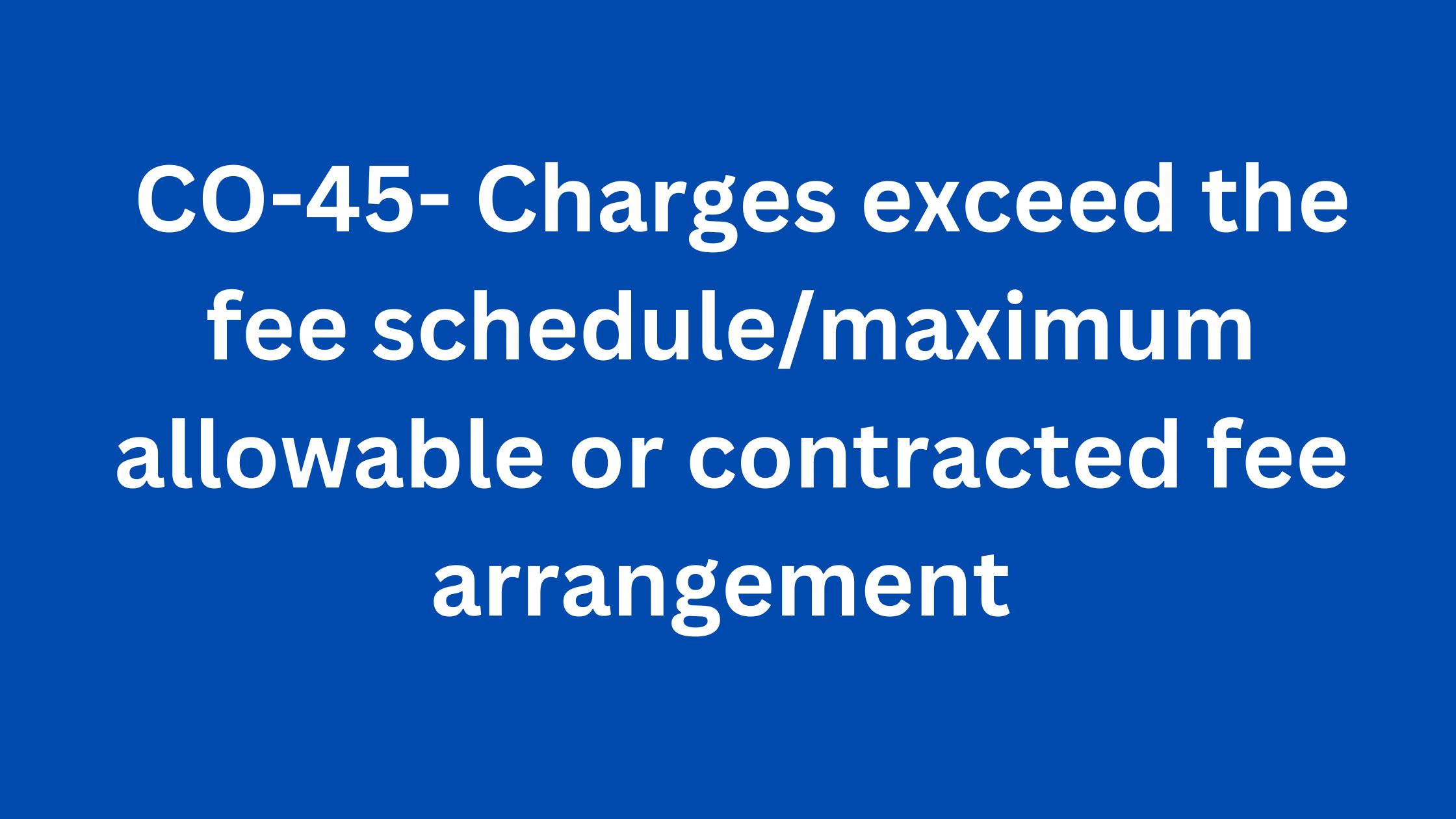As a physician, dealing with insurance companies and their complex payment systems can be a frustrating and confusing experience. One of the most common issues physicians encounter is the CO 45 denial code, which appears on Explanation of Benefits (EOB) or Electronic Remittance Advice (ERA) when the insurance plan’s contractually allowed amount is less than the billed charges.
What is CO 45 Denial Code?
“Charges exceed the fee schedule/maximum allowable or contracted/legislated fee arrangement”
CO 45 is a denial code used by insurance companies to indicate that the billed amount for a healthcare service rendered by a physician is higher than what the insurance plan has contractually allowed. In other words, it refers to the difference between what the physician charged and the insurance plan agreed to pay for that service.
Why is CO 45 Denial Code Important?
CO 45 denial is important because it affects both the physician and the patient. When a physician receives a CO45 denial , they will not be paid the full amount they billed for the healthcare service rendered. The physician will either have to write off the difference between the billed and the allowed amount or adjust the amount.
On the other hand, the patient is not responsible for paying the difference between the billed amount and the allowed amount, nor can it be billed to other insurance plans as per contractual obligations. Thus, the CO45 denial can lead to financial losses for physicians and confusion for patients.
How to Handle Denial Code CO45?
To handle CO 45 denial code, physicians can take the following steps:
- Review the EOB/ERA – Physicians should carefully review the EOB/ERA to understand why the CO 45 denial code was issued. They should check if the billed amount was correct and the insurance plan’s allowed amount was calculated accurately.
- Contact the Insurance Company – Physicians can contact the insurance company to discuss the CO45 denial code and request a re-evaluation of the claim. They can provide additional information to support their billed amount, such as medical records, procedure codes, and other relevant documentation.
- Write off the Difference – If the insurance company does not change the decision, physicians should write off the difference between the billed amount and the allowed amount as per contractual obligations.
EXAMPLE 1
| Billed Amt. | Allowed Amt. | Paid Amount | Patient Responsibility (PR) | Write off | Remarks Codes |
| $500 | $400 | $320 | $80 | $100- CO-45 | CO 45 |
As per EOB claim billed amount was $500 and allowed amount is $400 and as per Medicare insurance paid amount is 80% of allowed amount so paid amount is $320, patient responsibility is $80 and remain $100 is write-off adjustment as CO-45 denial.
EXAMPLE 2
For example, if billing company submit a claim of $100 dollars and the insurance company only covers the service for $80 , in that case $20 will be denied as CO-45
If they do this they will then send you a return code of CO-45. In this case, you got paid. The payer is just letting you know what portion of the bill exceeds the amount in the insurance contract.
EXAMPLE 3
The insurance company and the provider, agree to make the max allowable fee for any surgery $200. But for a post-surgery the bill is $250.
The additional $50 will be a Contractual Obligation (CO) . $50 is a contractual adjustment that the provider needs to write-off. So, this contractual obligation (CO) assigns the financial responsibility to the provider.
Medical Billing Paid, W/O and Allowed amount Formula-
Billed Amount (BA) = Allowed Amount (AA) + Write-Off (W/O)
Allowed Amount (AA) = Paid Amount (PA) + Patient responsibility (PR)
Patient responsibility (PR) = Allowed Amount (AA)- Paid Amount (PA)
Paid Amount (PA) = Allowed Amount (AA) – Patient responsibility (PR)
Conclusion:
In summary, the CO-45 denial code is a common issue physicians encounter when dealing with insurance companies. It indicates that the billed amount for a healthcare service rendered is higher than what the insurance plan has contractually allowed. Physicians can take steps to handle the denial code CO45, such as reviewing the EOB/ERA, contacting the insurance company, and writing off the difference.
Related Articles:
Denial Code PR 119 – Maximum Benefit Met
CO 97 Denial Code-Bundled Denial in Medical Billing
CO 50 Denial Code|Not Deemed A Medically Necessary Procedure
CO 109 Denial Code Description
The author and contributor of this blog "NSingh" is working in Medical Billing and Coding since 2010. He is MBA in marketing and Having vaste experience in different scopes of Medical Billing and Coding as AR-Follow-up, Payment Posting, Charge posting, Coding, etc.

